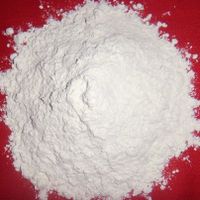Magnesium hydroxide

| |
| Names | |
|---|---|
| IUPAC name
Magnesium hydroxide
| |
| Systematic IUPAC name
Magnesium hydroxide | |
| Other names
Brucite
Magensium dihydroxide Milk of magnesia | |
| Identifiers | |
| Jmol-3D images | Image |
| |
| Properties | |
| Mg(OH)2 | |
| Molar mass | 58.3197 g/mol |
| Appearance | White solid |
| Odor | Odorless |
| Density | 2.3446 g/cm3 |
| Melting point | 350 °C (662 °F; 623 K) decomposes |
| Boiling point | Decomposes |
| 0.00064 g/100 ml (25 °C) 0.004 g/100 ml (100 °C) | |
| Solubility | Reacts with acids |
| Vapor pressure | ~ 0 mmHg |
| Thermochemistry | |
| Std molar
entropy (S |
64 J·mol−1·K−1 |
| Std enthalpy of
formation (ΔfH |
−924.7 kJ/mol |
| Hazards | |
| Safety data sheet | Sigma-Aldrich |
| Flash point | Non-flammable |
| Related compounds | |
| Related compounds
|
Calcium hydroxide Strontium hydroxide Barium hydroxide |
| Except where otherwise noted, data are given for materials in their standard state (at 25 °C [77 °F], 100 kPa). | |
| Infobox references | |
Magnesium hydroxide is inorganic compound with formula Mg(OH)2. It is often known as milk of magnesia, because of its milk-like appearance as a suspension. The solid mineral form of magnesium hydroxide is known as brucite. Suspensions of magnesium hydroxide in water are used as an antacid to neutralize stomach acid, and as a laxative. The diarrhea caused by magnesium hydroxide carries away much of the body's supply of potassium, and failure to take extra potassium may lead to muscle cramps. Magnesium hydroxide is also used as an antiperspirant underarm deodorant.
Contents
[hide]Properties
Chemical
Magnesium hydroxide reacts with acids, forming the magnesium salt of said acid and water.
- Mg(OH)2 + 2 HCl → MgCl2 + 2 H2O
Magnesium hydroxide decomposes when heated at high temperatures.
- Mg(OH)2 → MgO + H2O
Physical
Magnesium hydroxide is an inorganic compound with the chemical formula of hydrated Mg(OH)2. While magnesium hydroxide has a low solubility in water, with a Ksp of 1.5×10−11, it is large enough that it will partially dissolve to produce ions in the solution, forming the suspension. A relatively high concentration of magnesium or hydroxide ions would be required to revert the suspension to the solid precipitate by reversing the equilibrium.
In this suspended form, magnesium hydroxide is a common component of antacids and laxatives; it interferes with the absorption of folic acid and iron. The antacid properties come from the hydroxide ions which are responsible for neutralizing the acid.
Preparation
Magnesium hydroxide is composed of magnesium ions and hydroxide ions and it will precipitate whenever the two are present together - ie, combine in a metathesis reaction. The reaction is as follows:
- Mg2+ (aq) + 2 OH− (aq) → Mg(OH)2 (s)
It can be easily prepared by mixing sodium hydroxide or potassium hydroxide with magnesium sulfate.
- 2 NaOH + MgSO4 → Mg(OH)2 + Na2SO4
- 2 KOH + MgSO4 → Mg(OH)2 + K2SO4
Note that it is extremely hard to filter milk of magnesia: magnesium hydroxide forms a slime-like gel that clogs most filters, and even strong vacuum does not help much.
Very pure magnesium hydroxide can be obtained by reacting magnesium metal with water, which works much better with hot water than cold water.
- Mg + 2 H2O → Mg(OH)2 + H2
Magnesium metal does not react with alkali hydroxides, thus the hydroxide cannot be produced this way.
Availability
Magnesium hydroxide is sold by chemical suppliers and can be bought cheaply online.
Some companies, like Martin Marietta Magnesia Specialties, deal in high purity products.
It's also available in some drugstores as an antacid.
Projects
- Make magnesium salts
- Make magnesium oxide
- Antiacid
Handling
Safety
Magnesium hydroxide has low to no toxicity, though if too much is ingested it may cause digestion issues and hypermagnesemia. It's non-flammable and non-explosive.
Storage
Magnesium hydroxide should be stored in closed bottles, away from open air to prevent it from absorbing carbon dioxide or sulfur dioxide from air.
Disposal
Magnesium hydroxide can be safely thrown out with your normal garbage or dumped in plant-less soil.
References
Relevant Sciencemadness threads
- Chemical pages without CAS Registry Number
- Articles without EBI source
- Chemical pages without ChemSpiderID
- Chemical pages without DrugBank identifier
- Articles without KEGG source
- Articles without InChI source
- Articles without UNII source
- Articles containing unverified chemical infoboxes
- Chemical compounds
- Inorganic compounds
- Magnesium compounds
- Bases
- Hydroxides
- Materials unstable in acidic solution
- Easily prepared chemicals
- Minerals
- Irritants
- Air-sensitive materials